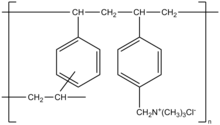Colestyramine
 | |
| Clinical data | |
|---|---|
| Routes of administration | gastrointestinal |
| ATC code | |
| Pharmacokinetic data | |
| Metabolism | bile acids |
| Elimination half-life | .1 hr |
| Excretion | feces |
| Identifiers | |
| CAS Number | |
| ECHA InfoCard | 100.031.143 |
| Chemical and physical data | |
| Molar mass | Average MW exceeds 106 Daltons |
Cholestyramine or colestyramine (Questran, Questran Light, Cholybar) is a bile acid sequestrant, which binds bile in the gastrointestinal tract to prevent its reabsorption. The resin is a strong anion exchange resin, which means that it can exchange its chloride anions with anionic bile acids in the gastrointestinal tract and bind them strongly in the resin matrix. The functional group of the anion exchange resin is a quaternary ammonium group attached to an inert styrene-divinylbenzene copolymer.
Cholestyramine removes bile acids from the body by forming insoluble complexes with bile acids in the intestine, which are then excreted in feces. When bile acids are excreted, plasma cholesterol is converted to bile acid to normalize bile acid levels. This conversion of cholesterol into bile acids lowers plasma cholesterol concentrations. Bile acid sequestrants such as cholestyramine are primarily used to treat hypercholesterolemia, but can also be used to treat the pruritus, or itching, that often occurs during liver failure due to the liver's inability to eliminate bile.
Cholestyramine is also used to prevent diarrhea in Crohn's disease patients who have undergone post-ileal resection. The terminal portion of the small bowel (ileum) is where bile acids are reabsorbed. When this section is removed, the bile acids pass into the large bowel and attract water due to their osmotic effect, causing diarrhea. Cholestyramine prevents this increase in water by making the bile acids insoluble and osmotically inactive.
Available forms
Cholestyramine is available as powder form, in 4 gram packets, or in larger canisters. In the United States, it can be purchased either as a generic medicine, or as Questran or Questran Light (Bristol-Myers Squibb).
Dosage
4 to 8 grams once or twice daily, maximum dose 24 grams a day.
Side-effects
The following side effects have been noted.[1]
- Most frequent: Constipation
- Seldom: tooth discoloration, tooth enamel erosion, and premature tooth decay, all from prolonged oral exposure to the suspension
- Increased risk for gallstones due to increased cholesterol content of bile.
Warnings
Patients with hypothyroidism, diabetes, nephrotic syndrome, dysproteinemia, obstructive liver disease, kidney disease, or alcoholism should consult their doctor before taking this medication.[2] Other drugs should be taken at least one hour before or four to six hours after cholestyramine to reduce possible interference with absorption.
Patients with phenylketonuria should consult with a physician before taking Questran Light because that product contains phenylalanine.
Drug interactions
The following interactions have been noted.[3]
- Digitalis
- Estrogens and progestins
- Oral diabetes drugs
- Penicillin G
- Phenobarbital
- Spironolactone
- Tetracycline
- Thiazide-type diuretic pills
- Thyroid medication
- Warfarin
- Arava
Most interactions are due to the risk of decreased absorption of these drugs.
Duration of treatment
The duration of treatment is not limited, but the prescribing physician should reassess at regular intervals if continued treatment is still necessary.
Overdose
Principal overdose risk is blockage of intestine or stomach.
Other remarks
Cholestyramine may interfere in the absorption of fat soluble vitamins such as vitamins A, D, E, and K. There are no special considerations regarding alcohol consumption. [4]
References
- The Merck Index, 12th Edition. 2257
